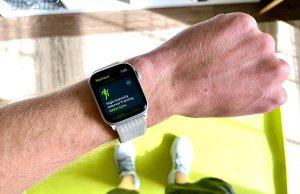
- Smartwatches have exploded in popularity, especially among Millennials and younger Gen-Xers: Companies like Garmin, Apple, and Fitbit all offer wearables that come loaded with features.
- Heavily marketed features of smartwatches include heart rate and stress monitoring, as well as blood O2 readings.
- While vital sign readings can be useful from a health standpoint, there are indications that smartwatches may increase the wearer’s risk of developing health anxiety, or hypochondria, by checking their vitals too often.
- Some features, like the Apple watch’s move, exercise, and stand rings, can be fun and rewarding to use, but it’s important to stay realistic about our daily health goals.
- Setting benchmarks for physical activity that are unachievable may increase your health anxiety. Closing those rings may require a little bit of creativity, too.
- If you want to stay consistent in meeting your health goals, consider using options like Apple Fitness+ to stay active with friends and family—and be sure to pick physical activities that you actually enjoy doing.
For the seventh time this morning, I ogle at my wrist, shuffling through the features on my smartwatch until I can see my heart rate. It’s bumping along at a cool 102 bpm. I’m sweating slightly, nervously tapping my foot against the carpet. Whether it’s from this third cup of coffee or the fact that I’ve managed to waste the first few hours of my workday procrastinating, I’m clearly anxious.
The funny thing is that I bought this smartwatch to encourage myself to be healthier and to help me track my stress—something that I’ll admit, often gets the best of me. Stress monitoring is a function that the watch offers, yet this morning, it’s hard to determine whether having that data really helps. Out of morbid curiosity, I mash some buttons until I can see my body’s stress level: The Garmin calculates this from my heart rate, blood oxygen, and activity levels, and scales my stress from 1-100. My stress level is (of course) sitting at a 92, so I follow the watch’s breathing prompts that aim to lower my heart rate and anxiety.
It seems like a safe bet that I’ll explode shortly into a puff of coffee and stress hormones, leaving only hipster glasses and a blog draft behind. I don’t have the clout or desire to start raining on the smartwatch parade here—I love my little wrist computer. I enjoy the pings and dings that indicate I’ve met my step goal or that congratulate me for actually having worked out for 30 minutes. I even get a nerdy kick out of receiving storm notifications from its built-in barometer.
Still, I have my doubts. Maybe they’re stemming from my own toxic, anxious thoughts, or maybe it’s a side effect of having read too many health articles that exploit my paranoid tendencies. But I wonder: Is there a connection between smartwatches and health anxiety?

Beware the Smartwatch: Hypochondria in Smartwatch Users
Hypochondria is a term that gets tossed around like a popular tweet: Everyone’s heard about it, most people can relate to it, and everyone seems keen to weigh in on the issue. The truth is that health anxiety, properly known as hypochondria, is a really popular subject online and has been for ages. There are endless Reddit threads, tweets, and a shared cultural knowledge that googling any minor physical symptoms will likely result in a self-diagnosis of cancer.
Adding fuel to the fire is (drum roll): smartwatches. They’re a newer technology, and although jam-packed with tech, their heavily marketed features, like Apple or Garmin’s heart monitoring systems, just aren’t as advanced as professional equipment is yet—and that’s exactly why people with heart issues that cause palpitations or other abnormalities including atrial fibrillation (AF) may be at the highest risk for developing symptoms of health anxiety from wearing a smartwatch.
One report, published in the Cardiovascular Digital Health Journal found that a woman’s smartwatch gave her 55 AF warnings over one year. A closer evaluation of the watch’s data found that its EKG system may have been receiving inconclusive data but still interpreting that data falsely as a health alert. This may have contributed to her being diagnosed by a psychologist with hypochondria. Data collected from her smartwatch showed that the woman was checking herself for heart abnormalities almost three times a day, precisely 916 times over the course of just one year.
Many smartwatches offer monitoring systems that detect stress and offer breathing prompts to lower your heart rate and help you relax. You may find this option to be a useful tool, but if tracking your vital signs this closely feels overwhelming, then ditch it. When it comes to EKG readings and blood O2 measurements, those who are healthy probably don’t need to check this data too often. If you find yourself compulsively checking for heart or circulatory abnormalities, try disabling these features; or better yet, talk to a mental health professional if you’re worried you have health anxiety.
Yes, There’s More to Life Than Closing Your Rings
Besides their current EKG capabilities, one of the most compelling (and addicting) features of Apple’s smartwatches are the three rings long associated with their fitness-oriented smartwatches. In a nutshell, Apple will track a wearer’s daily activity level with three different metrics: move, exercise, and stand. Closing the rings is a personal achievement, and Apple’s eye-catching visuals track the wearer’s progress throughout the day, as the rings slowly close.
It’s a fun, compelling way to stay in shape, but the line between hypochondria and achieving fitness goals can be easily blurred. Here are some ways to rule each ring and cut out any health anxiety that might come with it.
- Move: The move ring is closed by burning your set number of calories — which means your calorie goal needs to be realistic. Apple may calculate your calorie goals using your body mass index, but as the wearer, you need to be critical when setting your goals. Consider your age, fitness level, time constraints, and mental health. It may not be possible to burn 800 calories each day during the workweek, but 400 or 500 calories? These numbers may be attainable. Don’t set yourself up for failure — create a movement goal that reflects what you can do and doesn’t add to your anxiety about keeping in shape.
- Exercise: The exercise ring is closed by completing 30 minutes of physical activity, which can be any form of exercise, from power walking to weightlifting. This ring might be easier to close for some people, and it probably will require carving time out of your schedule to work out. If you adjust your schedule accordingly, you can fill both the move ring as well as the exercise ring in one fell swoop. But keep in mind that you might not have time each day for 30 minutes of activity. If you’re overwhelmed, sick, or too tired, go easy on yourself and take a rest day.
- Stand: The stand ring is closed when you get up and move around for at least a minute across 12 different hours of your day. During the workday, get up and take a break. Walk to the end of the hall, or take a quick stroll down the street for coffee. Standing is healthier than sitting (hence this smartwatch goal). Getting up once every hour may feel unimportant, but it increases blood flow to our legs and lower back.
Apple has designed their ring system well; maybe too well, for some of us. But just like any other piece of technology, there’s a fine division between benefiting from a product and becoming over-reliant on it. If you find yourself in a negative headspace because of failing to close your rings, take a mental step back: The rings aren’t real, and it’s just a smartwatch. It’s counterproductive to worry excessively about your health while trying to be healthier. Stress, even when well-intentioned, has a detrimental and draining effect on the body and mind. Finding a way to make exercise fun is essential to actually doing it.
You can also consider adding a little competition to the mix to spice things up. Pit yourself against friends and family in weekly or monthly challenges using Apple Fitness+, Garmin Connect, or Fitbit Premium — but be sure to set health goals that are realistic.
I don’t really like lifting weights, but I do love hiking, climbing, and fishing. By choosing forms of exercise that match your personality, you’ll feel less like working out is an obligation. It can become a simple way to keep doing the things you love, without feeding the hypochondriac minion inside you.
Current Consensus: Smartwatch Data Can Be Helpful In Moderation
Like most health-oriented products, it’s up to consumers to use their smartwatch wisely. But don’t assume that whistleblower groups aren’t keeping close tabs on smartwatch brands. When Google acquired Fitbit for over $2 billion this year, the EU’s European Data Protection Board (EDPB) had to move quickly to ensure that consumer’s health data wouldn’t be collected and sold to third parties for advertising purposes.
Beyond the potential for privacy violations, medical researchers seem divided about whether smartwatches are beneficial from a health standpoint. From one angle, research suggests that it’s best for physicians to not discount the benefits of a patient being able to monitor their own vital signs at home, especially if they’re at risk for developing potentially life-threatening symptoms. But on the other hand, some experts warn that smartwatches are making people, especially healthy people, more anxious about their physical wellbeing. This argument is partially based on the fact that smartwatch features like EKG and blood O2 systems aren’t as effective as professional equipment, so the likelihood of getting an inaccurate and potentially alarming health warning is increased.
Health anxiety is real—from valid concerns about our information being exploited to worrying excessively about conditions we probably don’t have. As one popular tweet reads, “the hypochondria is the powerhouse of the unwell.” Personally, I think I’ll be keeping my smartwatch: And as for its stress monitoring capacities, I’ve yet to make up my mind. So far, the little guy seems correct in diagnosing me as perpetually anxious. It’s hard to know if my smartwatch contributes to my stress levels, but it’s definitely made me more aware of how often I’m stressed. For now, I might as well rely on this wrist computer anyways—I know better than to try googling any of my stress-related symptoms.













